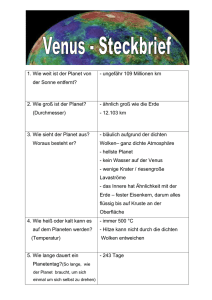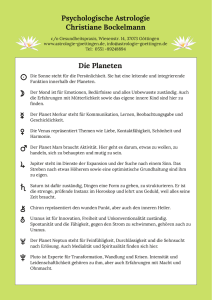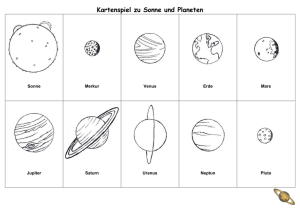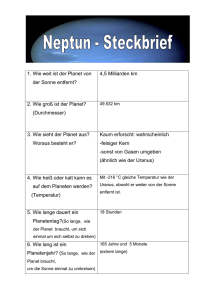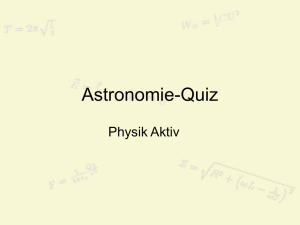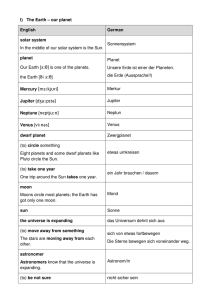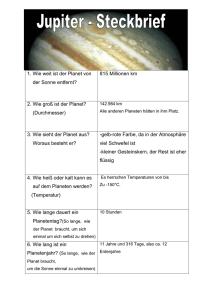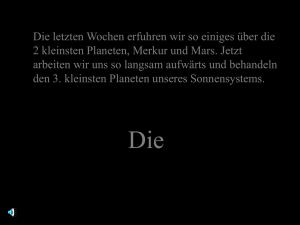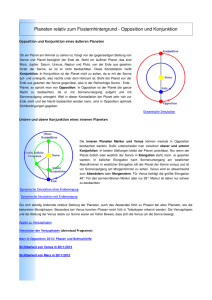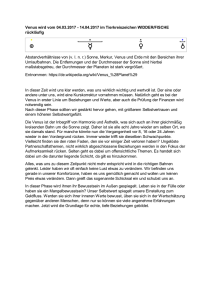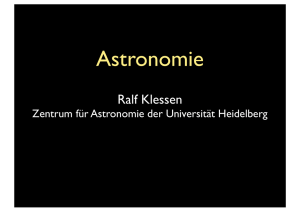CV/Resume - ProZ.com
Werbung
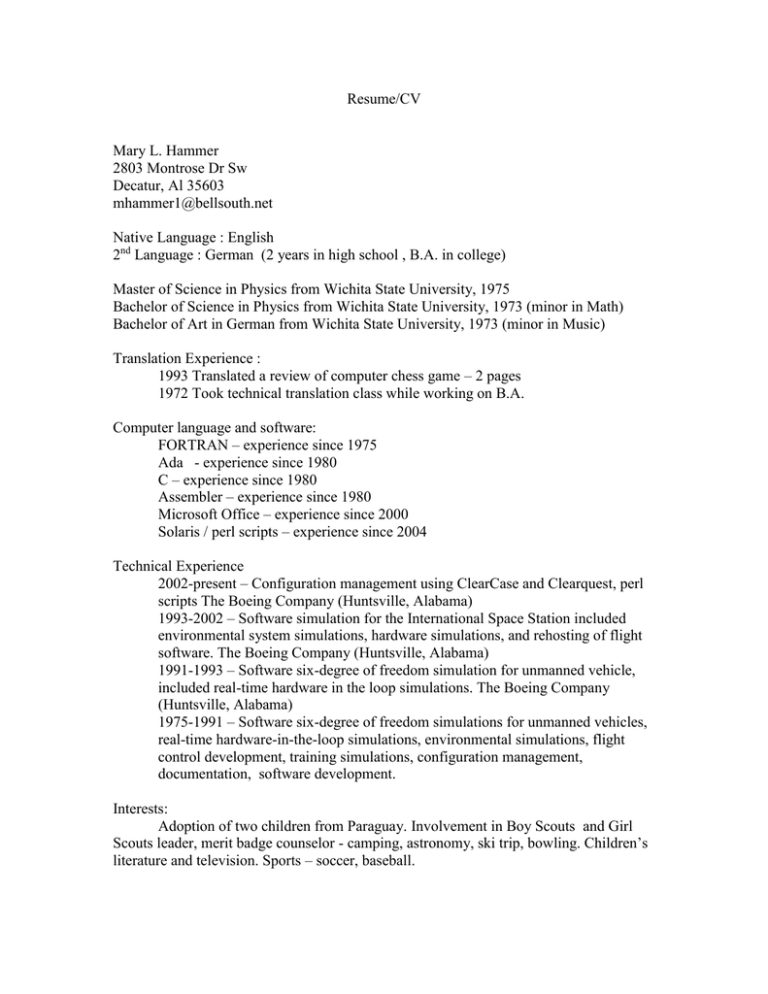
Resume/CV Mary L. Hammer 2803 Montrose Dr Sw Decatur, Al 35603 [email protected] Native Language : English 2nd Language : German (2 years in high school , B.A. in college) Master of Science in Physics from Wichita State University, 1975 Bachelor of Science in Physics from Wichita State University, 1973 (minor in Math) Bachelor of Art in German from Wichita State University, 1973 (minor in Music) Translation Experience : 1993 Translated a review of computer chess game – 2 pages 1972 Took technical translation class while working on B.A. Computer language and software: FORTRAN – experience since 1975 Ada - experience since 1980 C – experience since 1980 Assembler – experience since 1980 Microsoft Office – experience since 2000 Solaris / perl scripts – experience since 2004 Technical Experience 2002-present – Configuration management using ClearCase and Clearquest, perl scripts The Boeing Company (Huntsville, Alabama) 1993-2002 – Software simulation for the International Space Station included environmental system simulations, hardware simulations, and rehosting of flight software. The Boeing Company (Huntsville, Alabama) 1991-1993 – Software six-degree of freedom simulation for unmanned vehicle, included real-time hardware in the loop simulations. The Boeing Company (Huntsville, Alabama) 1975-1991 – Software six-degree of freedom simulations for unmanned vehicles, real-time hardware-in-the-loop simulations, environmental simulations, flight control development, training simulations, configuration management, documentation, software development. Interests: Adoption of two children from Paraguay. Involvement in Boy Scouts and Girl Scouts leader, merit badge counselor - camping, astronomy, ski trip, bowling. Children’s literature and television. Sports – soccer, baseball. Music – play piano, string bass, clarinet, played in band and orchestra (including community orchestra 1992-1995). Music theory. References available upon request. Sample translations: Viele Flugzeuge starten und landen auch bei Tag mit eingeschalteten Scheinwerfern. Die Landescheinwerfer können die Gefahr der Kollision von Vögeln mit Flugzeugen verstärken. Ornithologen sprechen vom so genannten Sonneneffekt. Vögel interpretieren instinktiv die helle Sonnenscheibe als hindernisfreien Fluchtweg. Landescheinwerfer können bewirken, dass der überraschte Vogel direkt auf das helle Licht zusteuert und einen Zusammenstoß verursacht. Hersteller von Flugzeugbeleuchtungen testen zurzeit ein neues Warnsystem. Zwei starke Blitzlampen werden an den Flügelwurzeln des Flugzeugs montiert. Die aggressiven Lichtblitze und die sich ändernde Frequenz der Blitzlampen sollen den Sonneneffekt ausschalten. Beschleunigt die Maschine beim Start, wird die Blitzfrequenz gesteigert, bremst das Flugzeug bei der Landung wird die Frequenz verlangsamt. Erste Versuche haben gezeigt, dass die neuen ABCLeuchten sehr wirksam sind. Many airplanes takeoff and land each day with bright headlights. The lights at the airports increases the danger of collisions with birds. Ornithologists speak about a socalled solar effect. Birds instinctively interpret the sunlight as a direction to an escape. Lights at the airport can cause a surprised bird to fly directly toward the bright light and cause a collision. Producers of airplane lights are now testing a new warning system. Two powerful lights have been mounted on the airplane’s wings. The bright lights and the different frequency of the light bulbs deactivates the solar effect. As the speed of the engine increases the frequency of the light is increased and when the airplane lands the frequency is shortened. First trials have shown that the new ABC-light is very effective. Willkommen an den Finanzmärkten: Was jetzt – als Tribut an die Finanzmärkte – die Entwicklungen am Markt erhellen kann, sind die Instrumente der Verhaltenspsychologie und Ökonomie, also die Betrachter der Rationalität bei Investitionsentscheidungen. Der dazugehörige Wissenschaftszweig heißt Behavioral Finance. Schon mal gehört im Zusammenhang mit immobilienwirtschaftlichen Fragenstellungen? Eher nicht, aber dort erschließt sich ein noch sehr weites und ungemein spannendes Feld.... Welcome to the financial markets: how, as a tribute to the financial markets, the disciplines of behavioral psychology and economy can illuminate the reasons behind investment decisions. The relevant discipline is known as Behavioral Finance. Have you perhaps heard of it in connection with real estate queries? Even if you have not heard the terms, this field is developing into a wide and exceedingly exciting area…. In jeder Sekunde ihres Sternenlebens verbraucht die Sonne 564 Millionen Tonnen Wasserstoff, um daraus 560 Millionen Tonnen Helium aufzubauen. Die restlichen 4 Millionen Tonnen, also 0,7% des Brennstoffs, werden in riesige Energiemengen umgewandelt. Die im Sonneninneren erzeugte Energie wird in den tieferen Schichten durch Strahlung, weiter außen durch Konvektion, also große Ströme heißen Materials, an die sichtbare Oberfläche, die Photosphäre transportiert, deren Temperatur knapp 6000C beträgt. Neben der elektromagnetischen Strahlung, also dem Licht und den Infrarot-, Ultraviolett- und Röntgenstrahlen, sendet die Sonne auch einen Strom elektrisch geladener Teilchen, den Sonnenwind ins All. Dieser erzeugt unter anderem die Polarlichter und Kometenschweife. Neben der Erde umkreisen 8 weitere Planeten die Sonne. Sie folgen dabei den Keplerschen Gesetzen, nach denen sich die Planeten in Sonnennähe schneller laufen als bei großem Sonnenabstand. Bei den inneren Planeten Merkur und Venus unterscheidet man folgende Positionen (sog. Aspekte): bei der oberen Konjunktion zur Sonne steht der Planet hinter der Sonne und ist unbeobachtbar. In unterer Konjunktion befindet sich der Himmelskörper zwischen Sonne und Erde und kann ebenfalls nicht beobachtet werden. Bei der größten östlichen oder westlichen Elongation erreicht der Planet seinen maximalen Winkelabstand von der Sonne und leuchtet als Abend- oder Morgenstern. Die günstigste Stellung eines äußeren Planeten (wie z.B. Saturn) ist die Opposition, bei der er von der Erde aus gesehen, der Sonne genau gegenübersteht. Er hat dann seinen kleinstmöglichen Abstand vom irdischen Beobachter erreicht und ist die ganze Nacht hindurch zu sehen. Merkur ist, ähnlich wie unser Mond, eine atmosphärenlose Kraterwelt, während Venus viele erdähnliche Landschaftsformen besitzt. Ihre fast ganz aus Kohlendioxid bestehende Atmosphäre erzeugt auf der Planetenoberfläche einen Luftdruck, der den irdischen Wert um etwa das 100fache übertrifft. Der Treibhauseffekt führt zu Bodentemperaturen um +480C. Während Mars einen etwa 24-Stunden-Tag hat, dreht sich Venus in 243 Erdentagen einmal um ihre Achse, und zwar "verkehrt herum", so dass die Sonne im Westen aufgeht. Mars besitzt eine dünne Atmosphäre, die wie die Venuslufthülle aus Kohlendioxid besteht. Der Bodenluftdruck ist jedoch sehr klein (ca. 1% des irdischen Wertes). Die vereisten Polkappen bestehen aus Kohlensäure- und Wassereis, das bei Erwärmung im Frühjahr wegen des niedrigen Luftdruckwertes nicht schmilzt, sondern direkt verdampft. Da die In each second of our star’s life it converts 564 million tons of hydrogen into 560 million tons of helium. The remaining 4 million tons, about .7%, of the available material, is converted into a tremendous energy source. In the deepest layers of the sun’s interior the energy is transported by radiation. In the middle layers streams of hot material are moved by convection. At the surface of the sun the temperature is about 6000C. In addition to the electromagnetic radiation, light in the infrared, ultraviolet and x-ray regions of the spectrum are sent in a stream of particles by the solar wind into space. These cause the aurora borealis and tails of comets. In addition to the earth eight more planets circle the sun. Their orbits obey the laws of Kepler, that is the planets nearer the sun, revolve faster than those at greater distances. The inner planets are Mercury and Venus and have the following positions: at upper conjunction the planet is behind the sun and cannot be observed from the Earth. At lower conjunction the planet is between the sun and the earth and again cannot be observed. At the largest easterly or westerly elongation the planet makes the largest angle with the sun and becomes an evening or morning star. The best time to observe the outer planets, for example Saturn, is at opposition, when the planet is opposite the sun, and the planet can be seen throughout the entire night. Mercury, like our moon, does not have an atmosphere and is covered with craters, while Venus has many earthlike land features. Its whole atmosphere consists of carbon dioxide, which produces an atmospheric pressure about Bahn des Planeten stark elliptisch ist, schwanken die Oppositionsentfernungen stark. Ähnlich wie die Sonne besteht Jupiter zum größten Teil aus Wasserstoff und Helium, und man nimmt an, dass sich in seinem sehr heißen Zentrum ein Kern aus schweren Elementen gebildet hat. Die riesige Planetenkugel dreht sich in nur 9h50m einmal um sich selbst, so dass sie durch große Fliehkräfte deutlich abgeplattet ist. Schon bei 40facher Vergrößerung erkennt man, dass der zweitgrößte Planet des Sonnensystems, Saturn, von Ringen umgeben ist, die aus Milliarden von kleinen Teilchen bestehen. In den hellen, dichten Ringen beträgt die Teilchengröße rund 0,001mm. In schwach besetzten Einzelringen, in denen die Teilchen selten zusammenstoßen, kommen Brocken von 10m Durchmesser vor. Saturn hat die vielseitigste Mondfamilie. 23 Trabanten sind bekannt, von denen einige beachtliche Ausmaße haben. Andere Monde flankieren den F-Ring innen und außen und halten mit ihrer Schwerkraft die Ringteilchen zusammen wie ein Schäferhund seine Herde. one hundred times that of earth. The greenhouse effect leads to ground temperatures around +480 C. While Mars has nearly a 24-hour day, Venus rotates on its axis once in 243 earth days and truly the sun rises in the West. Mars has a thin atmosphere, which like Venus consists of carbon dioxide. The atmospheric pressure is much smaller (about 1%) of the earth’s pressure. The polar ice caps consist of frozen carbon dioxide and water ice, which do not melt in spring because of the low atmospheric pressure, but instead vaporizes. Because the planets’ orbits are elliptical the distance at opposition is large. Similar to the sun, Jupiter consists mostly of hydrogen and helium and one assumes, that in its hot interior there are heavy elements. The huge planet rotates in only 9h50m one time on its axis, so that the large forces have caused it to flatten. Although 40 times smaller, Saturn is the second largest planet in the solar system, and it is encircled by rings made up of millions of small particles. The thickest rings are made up of particles about .001 mm in diameter. In the faintest rings, in which the particles seldom collide, there are boulders as big as 10m in diameter. Saturn has the most varied moons system. 23 satellites are known, of which several are very large. Other moons flank the F-Ring, holding it together with gravitation, like a sheep dog holds his flock.
